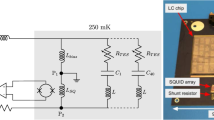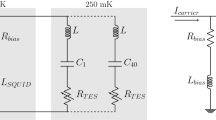Abstract
Frequency-domain multiplexing is a readout technique for transition-edge sensor bolometer arrays used on modern cosmic microwave background experiments, including the SPT-3G receiver. Here, we present design details and performance measurements for a low-parasitic frequency-domain multiplexing readout. Reducing the parasitic impedance of the connections between cryogenic components provides a path to improve both the crosstalk and noise performance of the readout. Reduced crosstalk will in turn allow higher-multiplexing factors. We have demonstrated a factor of two improvement in parasitic resistance compared to SPT-3G hardware. Reduced parasitics also permits operation of lower-resistance bolometers optimized for improved readout noise performance. We demonstrate that a module in the prototype system has comparable readout noise performance to an SPT-3G module when operated with dark TES bolometers in the laboratory.




Similar content being viewed by others
References
A.N. Bender et al., Proc. SPIE. 10708, 1070803 (2018). https://doi.org/10.1117/12.2312426
D. Barron et al., Proc. SPIE. 9153, 915335 (2014). https://doi.org/10.1117/12.2055611
B. Reichborn-Kjennerud et al., Proc. SPIE. 7741, 77411C (2010). https://doi.org/10.1117/12.857138
M. Hazumi et al., J. Low Temp. Phys. 194(5–6), 443 (2019). https://doi.org/10.1007/s10909-019-02150-5
K. Abazjian et al. for the CMB-S4 collaboration. arXiv:1610.02743
R.A. Hijmering, R. den Hartog, M. Ridder, A.J. van der Linden, J. van der Kuur, J.R. Gao, B. Jackson, Proc. SPIE 9914, 99141C (2016). https://doi.org/10.1117/12.2231714
A.N. Bender et al., Proc. SPIE 9153, 91531A (2014). https://doi.org/10.1117/12.2054949
T. de Haan, G. Smecher, M. Dobbs, Proc SPIE. 8452, 84520E (2012). https://doi.org/10.1117/12.925658
A.N. Bender, et al., J. Low Temp. Phys. (2019). https://doi.org/10.1007/s10909-019-02280-w
J.S. Avva et al., J. Low Temp. Phys. 193(3–4), 547 (2018). https://doi.org/10.1007/s10909-018-1965-5
M.A. Dobbs et al., Rev. Sci. Instrum. 83(7), 073113 (2012). https://doi.org/10.1063/1.4737629
A.N. Bender et al., Proc. SPIE 9914, 99141D (2016). https://doi.org/10.1117/12.2232146
K.D. Irwin, G.C. Hilton, Transition-Edge Sens. (2005). https://doi.org/10.1007/10933596_3
J. Clarke, A.I. Braginski, The SQUID Handbook (Wiley, Hoboken, 2004)
Metglas, Inc., Subsidiary of Hitachi Metals America, ltd, Conway, SC, http://www.metglas.com
Amuneal Manufacturing Corp., Philadelphia, PA, http://www.amuneal.com
A.E. Lowitz, A.N. Bender, M.A. Dobbs, A.J. Gilbert, Proc. SPIE 10708, 107081D (2018). https://doi.org/10.1117/12.2311984
Chase Research Cryogenics, Sheffield, UK, http://www.chasecryogenics.com
W. Everett et al., J. Low Temp. Phys. 193(5–6), 1085 (2018). https://doi.org/10.1007/s10909-018-2057-2
Acknowledgements
Work at the University of Chicago is supported by the National Science Foundation through Grant PLR-1248097. Work at Argonne National Laboratory is supported by UChicago Argonne LLC, Operator of Argonne National Laboratory (Argonne). Argonne, a U.S. Department of Energy Office of Science Laboratory, is operated under Contract No. DE-AC02-06CH11357. The McGill authors acknowledge funding from the Natural Sciences and Engineering Research Council of Canada, Canadian Institute for Advanced Research, and the Fonds de recherche du Québec Nature et technologies.
Author information
Authors and Affiliations
Corresponding author
Additional information
Publisher's Note
Springer Nature remains neutral with regard to jurisdictional claims in published maps and institutional affiliations.
Rights and permissions
About this article
Cite this article
Lowitz, A.E., Bender, A.N., Barry, P. et al. Performance of a Low-Parasitic Frequency-Domain Multiplexing Readout. J Low Temp Phys 199, 192–199 (2020). https://doi.org/10.1007/s10909-020-02384-8
Received:
Accepted:
Published:
Issue Date:
DOI: https://doi.org/10.1007/s10909-020-02384-8




